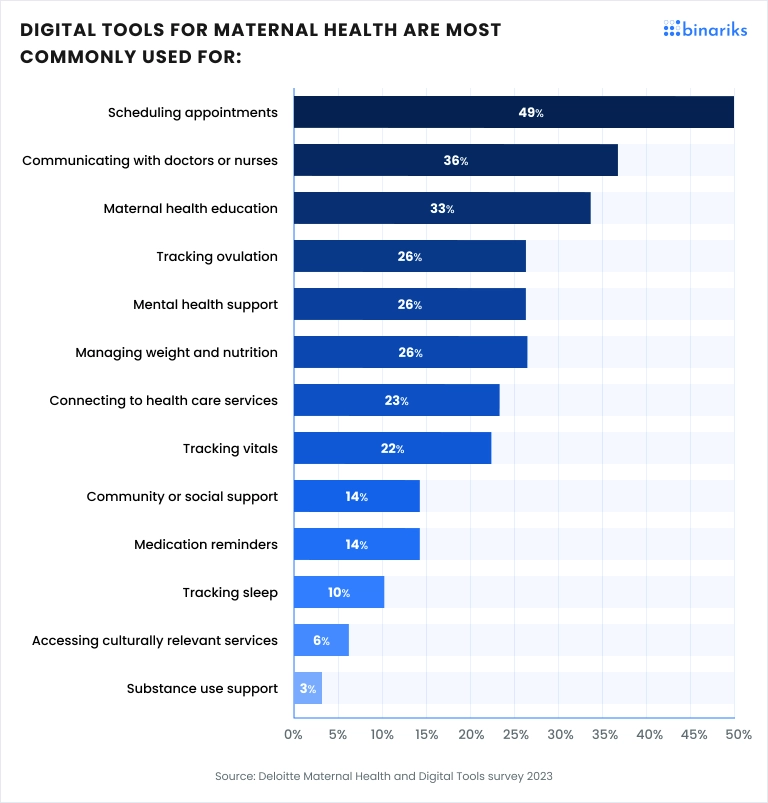Maternal health issues remain a critical challenge worldwide, with countless women facing life-threatening complications during pregnancy and childbirth even despite significant advancements in medical science.
In this landscape, innovations in maternal health are emerging as a beacon of hope, promising to forever change how maternal healthcare is delivered and experienced.
Digital health technologies for maternal health refers to the application of digital tools and technologies to improve maternal health outcomes. From remote monitoring to telehealth consultations, these innovations aim to bridge gaps in care, enhance patient engagement, and provide timely interventions.
As technology continues to evolve, its integration into maternal healthcare is poised to address some of the most pressing issues faced by expecting mothers and healthcare providers alike.
In this article, you will discover:
- The current state of global maternal health
- Key digital innovations transforming maternal healthcare
- The benefits these digital tools bring to maternal health outcomes
- Real-world examples of digital tools being implemented
- Challenges and barriers to the digitalization of maternal health
Join us as we explore how digital transformation reshapes maternal healthcare, offering new hope and possibilities for mothers and their babies.
Current state of maternal health
Maternal healthcare technologies are fraught with numerous challenges that impede the well-being of mothers and their newborns. Here are some of the key issues:
- High maternal mortality rates:
In many parts of the world, maternal mortality remains unacceptably high. According to the World Health Organization, the global MMR in 2020 was 223 per 100,000 live births.
Achieving a global MMR below 70 by 2030 will require an annual reduction of 11.6%, a rate rarely achieved at the national level. Most of these deaths are preventable with timely interventions and adequate care.
- Disparities in access to care:
There are significant disparities in access to quality maternal healthcare, particularly in low- and middle-income countries and among marginalized populations in high-income countries. Factors such as geographical barriers, socio-economic status, and lack of healthcare infrastructure contribute to these disparities.
- Shortage of skilled healthcare providers:
A shortage of trained healthcare professionals, including midwives and obstetricians, exacerbates the challenges in maternal healthcare. This shortage is particularly acute in rural and underserved areas, where the need for skilled care is often greatest.
- High rates of complications:
Conditions such as preeclampsia, gestational diabetes, and postpartum hemorrhage are common complications that can have severe consequences if not properly managed. These conditions require timely diagnosis and intervention, often lacking in resource-limited settings.
- Mental health issues:
Maternal mental health is frequently overlooked, yet conditions like postpartum depression and anxiety are prevalent and can have lasting impacts on both mother and child. Addressing mental health is essential for holistic maternal care.
Improving maternal health is not only crucial for the well-being of mothers and their babies but also for wider societal benefit. Healthy mothers are more likely to raise healthy children, contributing to the overall health and productivity of communities.
The blooming digital era in maternal healthcare can lead to reduced healthcare costs, lower rates of maternal and infant mortality, and improved quality of life for families. In essence, investing in maternal health is investing in the future of society.
Key digital innovations in maternal health

Digital innovations for maternal health have introduced new ways to deliver care, monitor health, and support expecting mothers. Here are some of the most impactful tools in maternal health:
Telemedicine and remote monitoring (RPM)
Telemedicine involves using telecommunications technology to deliver healthcare services and consultations remotely. This includes video calls, phone consultations, and online messaging with healthcare providers who play a crucial role in guiding patients. Remote monitoring complements telemedicine by using devices and applications to track vital signs and other health indicators from a distance.
- Telemedicine platforms: These platforms enable virtual consultations between pregnant women and their healthcare providers, facilitating regular check-ups and timely medical advice without the need for in-person visits.
- RPM devices: Devices such as blood pressure monitors, glucose meters, and fetal heart rate monitors can transmit data to healthcare providers, enabling continuous monitoring of maternal and fetal health.
mHealth
Mobile health applications, or mHealth apps, are software programs designed to run on smartphones and tablets. These apps provide a range of services from health tracking to educational content and reminders.
- Health tracking: mHealth apps allow users to log symptoms, track pregnancy progress, and monitor health metrics like weight, blood pressure, blood sugar levels, fetal movements, sleep quality, and more.
- Appointment and medication reminders: Automated reminders ensure that women keep up with their prenatal visits and medication schedules.
Wearable technologies
Wearable technologies include smartwatches, fitness trackers, and specialized health monitors worn on the body. These devices collect and transmit health data in real time.
- Smartwatches and fitness trackers: These devices track physical activity, heart rate, sleep patterns, and other health metrics.
- Specialized pregnancy wearables: Devices designed for pregnancy can monitor fetal movements, uterine contractions, and other pregnancy-specific health indicators.
AI and data analytics
Leveraging complex algorithms and data analysis techniques helps to gain insights from large datasets. In maternal health, AI is primarily used for predictive analytics, risk assessment, and personalized care recommendations.
- Predictive analytics: AI algorithms analyze health data to predict potential complications such as preeclampsia or preterm labor.
- Personalized care recommendations: AI-driven tools can offer tailored advice and interventions based on a woman's unique health profile.
EHR and health information systems
Electronic health records and integrated health information systems are digital versions of patients' medical histories. These systems store comprehensive health information and facilitate seamless data sharing among healthcare providers.
- EHRs: Digital records that include a woman’s complete medical history, from preconception through postpartum care.
- Integrated Health Information Systems: Platforms that connect different healthcare providers and facilities, allowing for coordinated care and information sharing.
Each of the mentioned innovations is critical in transforming maternal healthcare, offering new monitoring, support, and intervention possibilities throughout pregnancy and beyond.
Benefits of digital innovations in maternal healthcare
The Deloitte Center for Health Solutions conducted a survey in the US in July and August 2023 among women who were pregnant in the previous two years. The study revealed that digital solutions for maternal healthcare could significantly boost health empowerment, with over 70% of respondents using these tools to manage specific health needs, surpassing mere access to healthcare or communication.
The survey indicated that digital tools could significantly enhance access to maternal health services. Nearly 60% of respondents believe these tools can improve communication with care teams, 55% see the potential for increased access to care, and 40% think they can help reduce out-of-pocket costs. Additionally, interviewees highlighted how digital tools can empower patients by amplifying their voices and experiences through actionable data.

Let's examine the main benefits more closely:
- Increased access to care: Telemedicine and remote monitoring technologies break down geographical barriers, allowing women in remote or underserved areas to receive timely medical consultations and care.
- Convenience and flexibility: Expectant mothers can consult with healthcare providers from the comfort of their homes, reducing the need for travel and the associated stress.
- Empowerment and education: Mobile health apps provide a wealth of information on pregnancy, childbirth, and postnatal care, empowering women to make informed decisions about their health and the health of their babies.
- Enhanced communication: Digital tools facilitate direct communication between patients and healthcare providers, ensuring continuous support and guidance throughout the pregnancy and postnatal period.
- Real-time health tracking: Wearable devices monitor vital signs, physical activity, sleep patterns, and other health indicators in real time, enabling early detection of potential issues and timely interventions.
- Seamless data sharing: Electronic health records (EHRs) enable the seamless sharing of patient information among healthcare providers, ensuring that all relevant data is available for comprehensive and coordinated care.
These advantages collectively contribute to a more accessible, efficient, and patient-centered approach to improving maternal health through digital innovation, ultimately leading to more positive health outcomes for mothers and their babies.
Challenges and barriers of maternal health digitalization
- Limited access to technology: Socioeconomic disparities may restrict access to digital tools and internet connectivity, particularly in underserved communities, hindering the adoption of maternal health digitalization.
- Privacy and data security concerns: The sensitive nature of maternal health data raises concerns about privacy breaches and data security risks, necessitating robust safeguards to protect patient information.
- Digital literacy and user engagement: Low digital literacy levels among specific demographics may impede the effective utilization of digital tools for maternal healthcare, requiring user-friendly interfaces and comprehensive training programs.
- Regulatory compliance: Stringent regulatory frameworks and compliance requirements in the healthcare sector pose challenges to developing and implementing digital solutions, necessitating time-consuming efforts to adhere to complex standards and guidelines.
- Integration with existing systems: Seamless integration with existing healthcare systems and interoperability between different platforms present technical challenges, requiring careful coordination and compatibility testing.
Examples of digital tools for maternal health
From apps to wearable devices, digital tools can make it easier for moms-to-be to stay healthy and connected with their healthcare providers. Let's take a look at some real-life examples.
Ovia Health
Ovia Health offers a suite of digital tools and applications designed to support women throughout their reproductive health journey, including pregnancy, fertility, and parenting. Its flagship app, Ovia Pregnancy, provides personalized health tracking, daily articles, and community forums for expecting mothers.
Ovia Health's platform also includes apps for fertility tracking, postpartum support, and parenting guidance, catering to women's diverse needs and preferences across different stages of motherhood.
Bloomlife
Bloomlife is a company that creates connected care platforms for maternal health.
They offer a service called Bloomlife Connects, a turnkey operating system that enables provider organizations to screen maternal and fetal risk more easily. It uses FDA-cleared connected devices to evaluate maternal and fetal health from home and offers digital health screenings and data analytics.
Bloomlife Connects offers real-time data, which allows for earlier intervention and identification of at-risk moms without frequent in-person appointments, paper forms, and manual processes.
Sama Fertility
Sama is an online clinic where women can receive professional and personalized fertility care and get all the needed help and guidance while bearing a baby. Sama aims to enable virtual appointments and remote monitoring from top clinicians.
Through its partnership with Binariks, Sama has been enhanced by a unified digital platform. This platform automates tasks, streamlines patient onboarding, appointments, lab orders, and medical records, and improves patient-provider communication.
Our expertise, among other things, in cloud and DevOps helped to ensure that patients have easy access to medical information and that staff can work and handle vast amounts of medical information efficiently.
While telehealth has made significant strides since the COVID-19 pandemic, its application in fertility health is still less widespread than in some other fields.
However, patients enjoy such innovative solutions, and Sama is gaining popularity. According to reviews, women appreciate how conveniently they can manage their time without sacrificing other plans and tasks. Also, they feel more engaged in the treatment process, clearly envision what's happening at which stage, and understand their healthcare providers' decisions.
Conclusion
Digital innovations in maternal health greatly improve the way expectant mothers receive care, making it more accessible, efficient, and personalized. However, challenges such as limited access to technology, data security concerns, and integration issues must be addressed to realize their full potential.
At Binariks, we realize the transformation in maternal health and its pace. We provide custom solutions that help healthcare businesses navigate challenges and implement cutting-edge digital tools. With a deep understanding of the healthcare industry, Binariks supports organizations in evolving their services to meet the needs of modern maternal health. By partnering with Binariks, you can improve patient care and contribute to a brighter future for maternal health.
FAQ
Share

